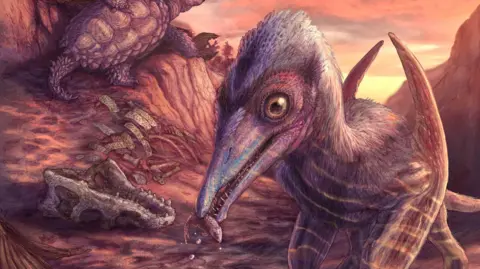New Species of Ancient Flying Reptile Unearthed in Arizona
In a remarkable discovery that pushes back the timeline of aerial life in North America, scientists have identified a new species of pterosaur, an ancient flying reptile that shared the skies with dinosaurs over 200 million years ago. Unearthed in the fossil-rich landscapes of Arizona, the jawbone of this prehistoric creature, initially discovered in 2011, has revealed its unique identity through advanced scanning technologies.

Led by researchers at the Smithsonian’s National Museum of Natural History, the creature has been formally named Eotephradactylus mcintireae. This name is a fitting tribute to the volcanic ash that played a crucial role in preserving its delicate fossilized remains within an ancient riverbed.
The findings, published in the prestigious journal Proceedings of the National Academy of Sciences, mark a significant milestone as this specimen is now considered the earliest known pterosaur discovered in North America. Its age, approximately 209 million years old, places it firmly in the Triassic period, a pivotal era of transition in Earth’s history.
“The bones of Triassic pterosaurs are small, thin, and often hollow, so they get destroyed before they get fossilised,” explained Dr. Ben Kligman, a researcher involved in the study. The exceptional preservation at this Arizona site, located within the Petrified Forest National Park, offers a rare glimpse into a world that existed when the supercontinent Pangaea was beginning to break apart.
This ancient riverbed has yielded a treasure trove of fossils, offering a comprehensive “snapshot” of a vibrant prehistoric ecosystem. Alongside the pterosaur remains, scientists have uncovered a diverse array of fossilized material, including fish scales, teeth, and even fossilized feces, known as coprolites. This rich fossil bed showcases a period of significant evolutionary transition, where ancient life forms that would later thrive coexisted with older species that eventually became extinct.
The wear patterns on the teeth of Eotephradactylus mcintireae suggest a diet consisting of prey with hard exteriors, likely primitive armored fish that inhabited the ancient rivers. This discovery underscores the potential for finding similar pterosaur remains in other Triassic-aged rock deposits worldwide. The researchers are optimistic that continued exploration of such sites will further illuminate the diversity and evolution of these fascinating early flying reptiles.
The study of these fossils not only reveals the specifics of a newly identified species but also provides invaluable context about the interconnectedness of life during the Triassic period. It confirms the coexistence of various animal groups, including early mammals, amphibians, and the ancestors of modern reptiles, painting a vivid picture of a dynamic and complex ancient world.
